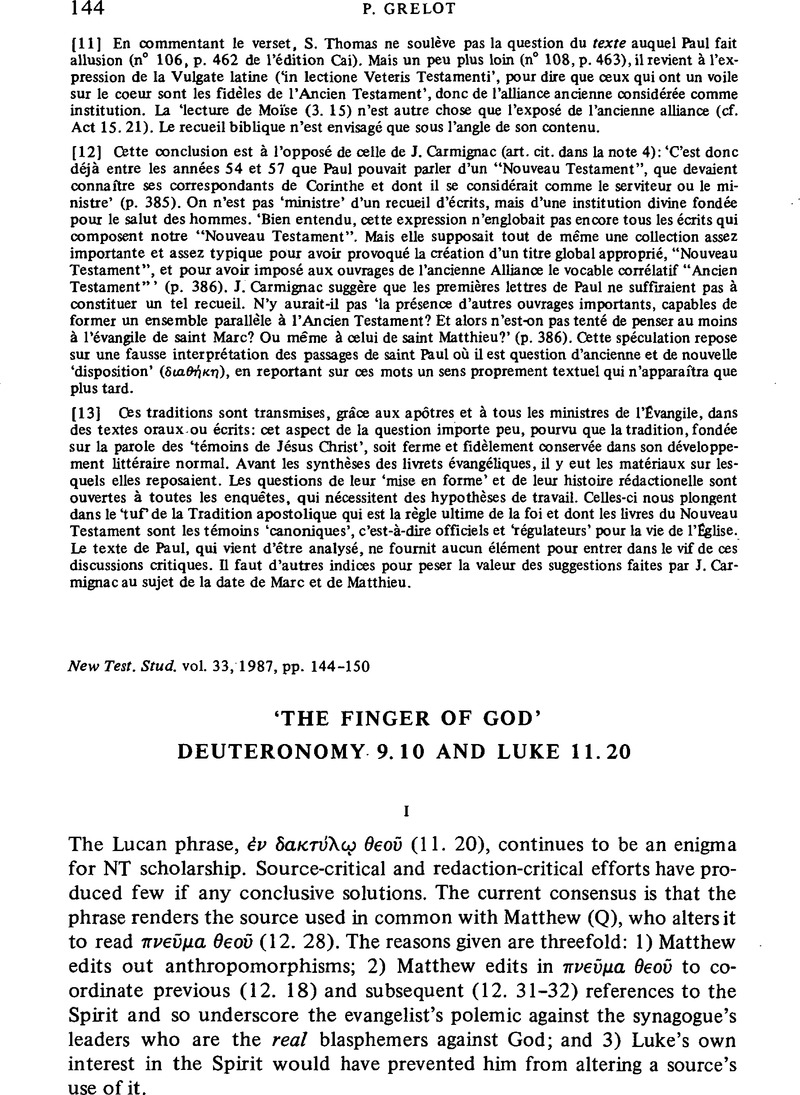No CrossRef data available.
Published online by Cambridge University Press: 05 February 2009

[1] Rodd, C. S., ‘Spirit or Finger’, ExT 72 (1960–1961) 157–8.Google Scholar
[2] Hamerton-Kelly, Robert G., ‘A Note on Matthew XII.28 par Luke XI.20’, NTS 11 (1964–1965) 167–9.CrossRefGoogle Scholar
[3] Marshall, I. Howard, Commentary on Luke (NIGNTC, Grand Rapids, 1978) 476Google Scholar; italics added.
[4] David P. Moessner calls the Central Section of Luke's gospel the ‘most intriguing yet confusing contour in the Luke-Acts landscape’ in his ‘Luke 9. 1–51: Luke's Preview of the Journey of the Prophet Like Moses of Deuteronomy’, JBL 102 (1983) 576Google Scholar; cf. the extensive bibliography he has compiled for research of the Central Section on 575–6, n. 2.
[5] Evans, C. F., ‘The Central Section of St. Luke's Gospel’, in Studies in the Gospels: Essays in Memory of R. H. Lightfoot (ed. Nineham, D. E., London, 1955) 37–53.Google Scholar
[6] For two works which have offered updated suggestions based upon Evans' lead, see Drury, John, Tradition and Design in Luke's Gospel (Atlanta, 1976)Google Scholar, and Goulder, M. D., The Evangelists' Calendar (London, 1978)Google Scholar; Craig Blomberg has offered a somewhat negative evaluation of these solutions in his ‘Midrash, Chiasmus, and the Outline of Luke's Central Section’, Gospels Perspectives: Studies in Midrash and Historiography (ed. France, R. T. and Wenham, D., Sheffield, 1983) 228–33.Google Scholar
[7] Esp. Sanders' introduction to LeDéaut, Roger, ‘Apropos a definition of Midrash’, Interp 25 (1971) 259–61Google Scholar; for an application of the method of comparative midrash to the Lucan parables of Lk 14–18, Sanders, J. A., ‘The Ethic of Election in Luke's Great Banquet Parable’, in Essays in OT Ethics (ed. Crenshaw, J. and Willis, J., (New York, 1974) 228–33.Google Scholar
[8] Sanders, ‘Ethic’, 255.
[9] ibid., 256–9. (Blomberg has challenged this thesis on two grounds: 1) the method Sanders describes is not midrashic since midrash always comments upon the biblical text and not vice-versa; and 2) the catchwords which Evans (and also Sanders) suggests connect the deuteronomic and Jesus traditions in the Central Section are not precise enough to warrant this model; Blomberg, ‘Midrash’, 221–8. Sanders, building upon LeDéaut and Bloch's, R. seminal work on midrash, ‘Midrash’, SDB 5 (1957) cols. 1263–81Google Scholar, claims that midrashic technique can also utilize biblical texts to illumine and interpret a new context of faith. Further, Blomberg fails to consider in his criticisms about Luke's imprecision that the evangelist is working with not one but two pre-formed traditions – biblical and Jesus (some of which were already written down). While Blomberg appeals to a level of precision more appropriate when commenting upon a single, static text, we must assume that the difficulty of arranging two traditions in parallel is considerably greater. Indeed, the presence of so many verbal and conceptual parallels as noted by Evans in his programmatic essay is a startling tribute to Luke's technical skills. Nevertheless, Blomberg's criticisms, here only touched on, call for more examples of how ‘comparative midrash’ illumines Luke's gospel; the purpose of this essay intends to be a positive response to that call.
[10] Cf. Evans, 44. Although it is possible to argue that Luke has Ex 31. 18 (cf. 8. 15) instead of Dt 9. 10 in mind when speaking of the δακτύλος θεοῡ, the larger context of the Central Section whether understood thematically or linguistically is based upon the deuteronomic narrative of Moses' career. This is the conclusion of Moessner's recent study, ‘Luke 9:1–51’, although ultimately for a different direction than presented in this essay.
[11] Rad, Gerhard von, Deuteronomy (OTL, London, 1966) 77–8.Google Scholar
[12] For a discussion of Lucan triads and their importance for understanding the structure of this pericope, we Danker, F. W., Luke (PC, Philadelphia, 1976) 94.Google Scholar
[13] Danker, F. W., Jesus and the New Age (St. Louis, 1972) 139.Google Scholar
[14] Cf. ibid. This rendering of the first saying of the second triad (21–22) is at odds with the consensus as given by Marshall, 476–8, who argues it rather continues Jesus' defence against those who link him with Satan. The parable envisaged by the saying depicts a struggle between Satan, ‘a strong one’, and Jesus, ‘a stronger one’. This battle is won by Jesus (both immediately through exorcism and ultimately through his death and resurrection) who then divides the satanic booty among his followers. There are difficulties with this interpretation: it is not entirely clear how the depiction of a serene Satan in verse 21 fits Luke's overall portrayal of him as an ever-active although defeated reality; nor is it clear just what a demonic booty might be that Jesus then redistributes to his disciples. Further, Marshall's interpretation of the parable disrupts the triadic structure common to Luke. As to the difficulty of a satanic agency in effecting the redistribution of Israel's inheritance to a reconstituted Israel, it seems clear that for Luke the history of evil and of the Evil One is always subordinated to the history of God's salvation. Thus, Satan's actions could be used (even intended?) by God to accomplish his redemptive purpose (cf. Lk 4. 5 ff; 22. 22 par Mk 14. 21; 22. 31–32; Acts 19. 15–16; et al.).
[15] In fact, it is Moessner's claim that the Moses-Deuteronomy typology centres on the motif of ‘journey to the promised land’, and it is this very motif that shapes the form and content of Luke's redaction of his traditions of Jesus' final journey to Jerusalem; 588–605.